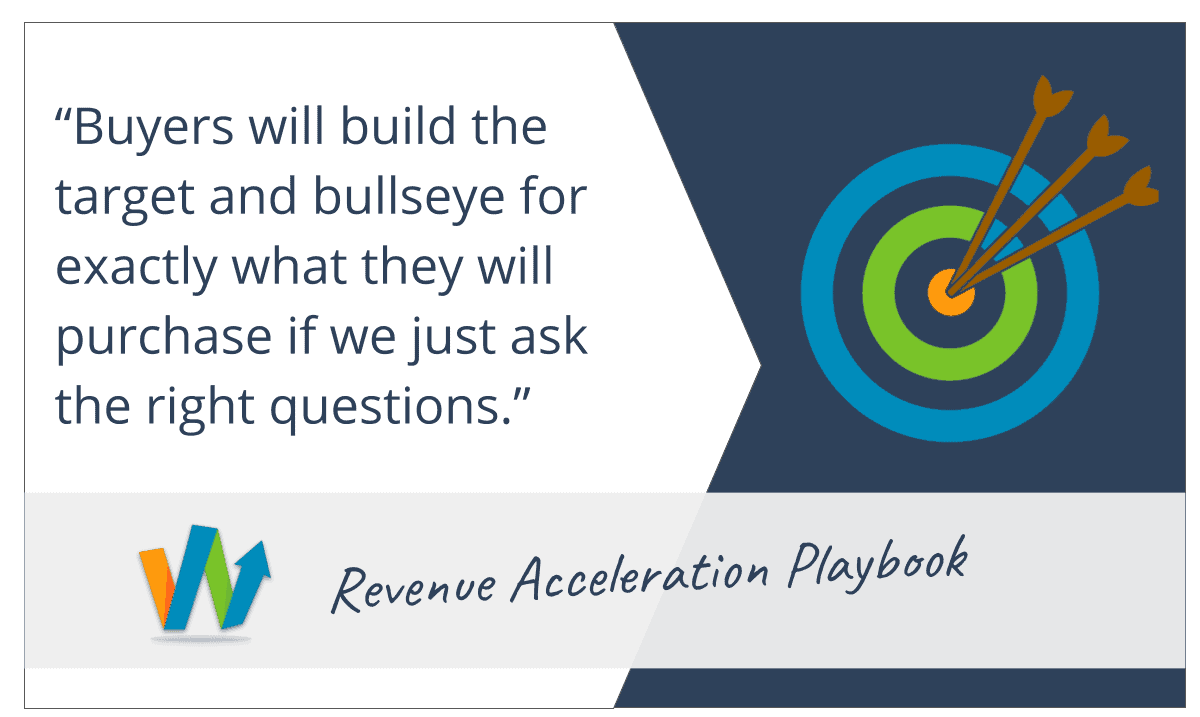 The heart of an authentic buyer journey lies in guided buyer discovery.
The heart of an authentic buyer journey lies in guided buyer discovery.
The reality, however, is that good buyer discovery is a broken skill.
Sales conversations should be about conducting GREAT buyer discovery. Ask the right questions, in the right order and you will see dramatic gains in deal production.
Let me share an example from recent work with an enterprise Human Resources technology company to show how buyer discovery can go off track and a few simple fixes that can make all the difference.
This HR Tech company serves Fortune 2000 firms by providing a career pathing solution that helps with several key HR goal areas. These include recruiting for hard to fill jobs, increasing job retention, and raising internal promotion rates from front-line staff positions into supervisory roles.
The sales and technical sales teams are extremely bright and the company has amazing outcome metrics and success stories for every one of these key HR goal areas. However, a very high percentage of their deals were stalling after the first or second call.
The root of the problem? They weren’t getting deep enough with buyer discovery to truly engage HR leaders through authentic conversations that progressed forward. The team knew they should start with buyer discovery but went off track when it came to executing deep discovery with guided buyer questioning at three levels.
Level 1 Discovery: Start with Buyer Goals 🎯
One big challenge the team faced was that even where they had a strong interest from a champion in a first call with a specific goal area, the deal would slow and then die as it moved into the organization.
My first ask for this sales team was to never stop at one buyer goal area. If a buyer opens up about a first goal area, try to connect to a second and third goal area and then get them to prioritize.
Just a handful of questions can quickly expand the conversation. Things like:
- Thanks for sharing more on your work with hard-to-recruit jobs. Is there also a focus on internal promotion for those hard-to-recruit jobs?
- Does your approach for hard-to-recruit jobs link to anything you are doing around retention?
- Across all three of these goal areas, is there one that gets you more excited? Or gets your VP or leadership team more excited? Is one of them a priority on this year’s business roadmap?
Many of your buyer’s goals are connected and expanding discovery to a second or third goal area shifts the energy in the conversation. It is no longer about trying to “sell the buyer.” Instead it becomes about exploring fit between the buyer’s goals and the company’s capabilities.
Broad goal discovery makes it easier for the buyer and the seller to partner on finding a goal area with higher urgency, a higher ROI goal, and a quicker path to a partnership. If you hit an internal roadblock in one goal area as you move through the buying process, it also gives flexibility and back up options.
Level 2 Discovery: Mine the Gap 🕳️
Another challenge was that as soon as a buyer confirmed an interest in any goal areas, the sales and technical sales team members would go into “insight pitching” mode.
They would share learnings from work with other clients, share data from cross-industry learnings, and share features of the product that might help with the goal area.
The assumption was “the buyer shared a goal, all I have to do now is impress them with all the evidence we have that we can achieve the goal.”
My second ask to this team was to stop telling your buyer how you can solve their problem and focus instead on educating the buyer on why they need to do something differently.
If the goal is filling difficult to recruit jobs, commit to asking three to four more questions along the following lines:
- Have you set a specific improvement goal for hard-to-fill jobs?
- What have you tried already? What has worked and not worked?
- If you could develop stronger career pathing into supervisory roles, would this help?
- What is it worth to achieve your target improvement? And who would get most excited?
I wanted this team to move from shallow discovery to true value discovery by asking three levels of questions – goal questions, gap questions, and gain questions. It is the buyer’s acknowledgement of a gap to goal or a specific gain that marks the beginning of a true sales conversation.
Level 3 Discovery: Anchor on the Gain Questions 📈
The final challenge was that the sales and technical sales team was not getting the buyer to confirm a specific gain or improvement that would get them excited.
My third ask to this team was to always get the buyer to identify a specific gain – whether emotional, financial, or organizational – that would get them excited. It is the payoff that comes from this gain that will anchor the deal and build velocity.
If the goal is filling difficult to recruit jobs, commit to asking three to four gain-oriented questions along the following lines:
- What is it worth to achieve your target improvement on recruiting?
- Would it increase job retention rates or decrease recruiting costs?
- What kind of gain on either outcome would get you excited? What kind of gain would get your team, or boss, or VP excited?
Guided Discovery is a Win-Win for Buyer and Seller
Buyers are busy. They appreciate it when we use their time well. Structured questions that explore a range of goal areas, educate buyers on their gaps, and look for a specific gain or improvement are a win-win for buyer and seller.
